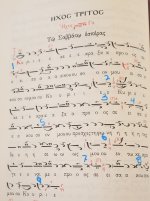You are using an out of date browser. It may not display this or other websites correctly.
You should upgrade or use an alternative browser.
You should upgrade or use an alternative browser.
Enharmonic Scale
- Thread starter Polemikos29
- Start date
There is not such a thing as "enharmonic fthora of Ke". There is only one enharmonic fthora (#4) after which you go on with the enharmonic scale. #4 (azem) is not only used as a fthora of the enharmonic scale, but also as a mark of yfesis (flat) of 3 moria according to Chrysanthos. In #1 you have the mark of permanent yfesi (flat) which is placed on Ke and requires permanently Zo flat. The problem is that even after fthora #4 many times you have to proceed with diatonic scale, even if there is not a diatonic fthora. This is very common in older editions. Unfortunately the only way to know when you have to go with the diatonic scale or the enharmonic is to know the music phrase.Your way of thinking is correct, but the actual first occurence of an enharmonic fthora is where you have marked (1) in your photo. This is the enharmonic fthora of Ke, therefore from this point until point (2) you are in the enharmonic scale.
tudorvolcano
Member
Generally, to go to the enharmonic scale for the Third mode, you need Atzem phthora on both Ga and Zo.When chanting using the enharmonic scale, like this hymn in the third tone, I always thought that you chant in the diatonic scale until you come across an enharmonic ftora like #4 in the picture. At that point, only then would you chant using the enharmonic scale...Am I mistaken?
Thanks so much!
View attachment 119056
Otherwise, it is the diatonic scale below Ga, and a diminished Zo above the Ga.
The enharmonic scale has the enharmonic diesis, by its definition, which some have said, but that is the Ancient Greek Tonic Diatonic semitone;
And actual Enharmonic diesis is 36/35, anything above that is not truly enharmonic.
What you actually need to have is a bigger Ga-Di interval, by having a lower Ga and Ni.
You can lower it so you have a septimal tone 8/7 between Ga and Di, and then Di-Ke will be the result of (4/3)/[(36/35)*(8/7)], which is 245/216.
This would be the enharmonic tetrachord in 72-EDO:

The only real time that you find a true enharmonic scale is Chroa Kliton (and sometimes, you do find the ditone 5/4 too, that is between Pa and Vu, when the Vu is raised to the Ga, while Chroa Kliton is put on Di); Echos Tritos, on the other hand, is for all intents and purposes, a diatonic mode.

